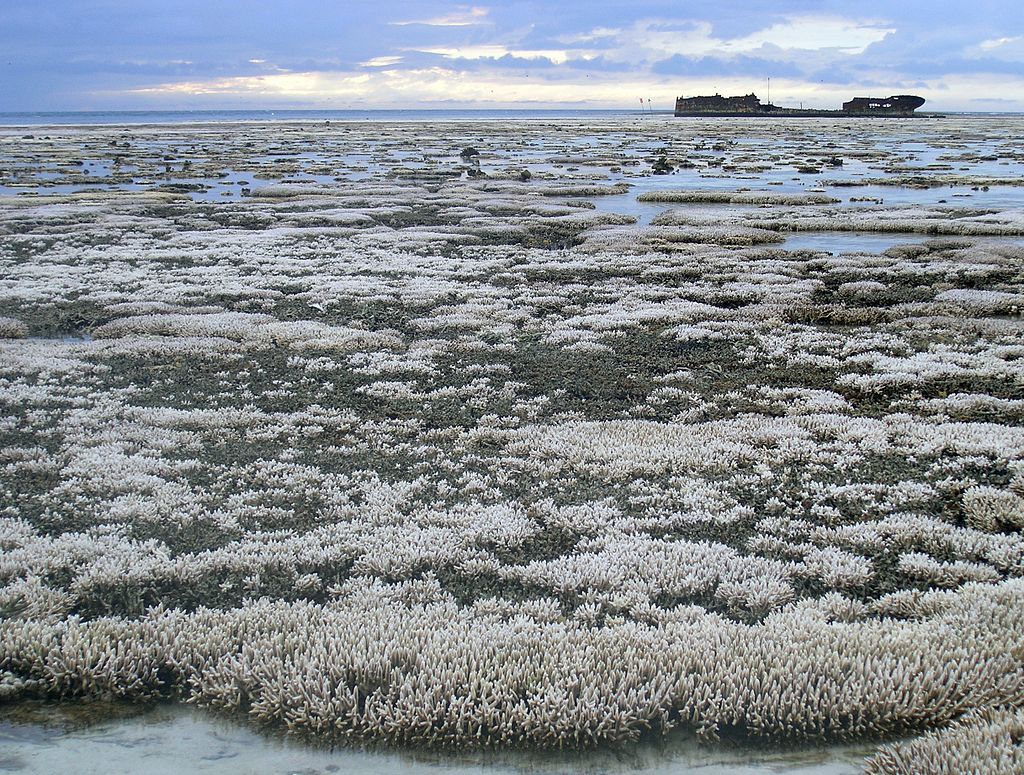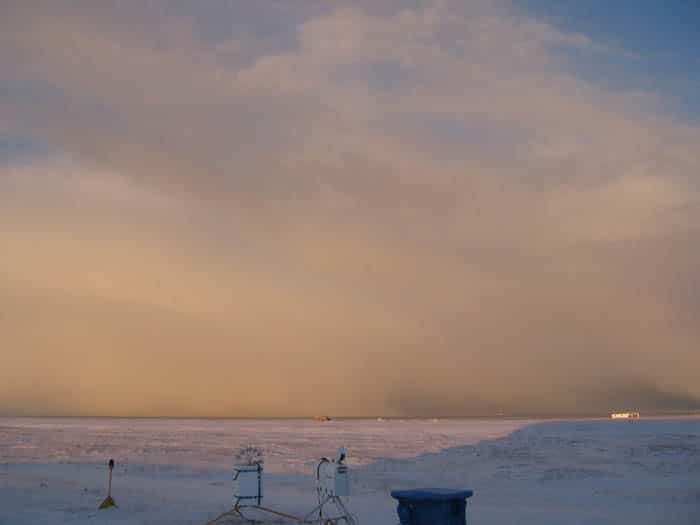This update on solar geoengineering in the troposphere summarises the latest developments on the Geoengineering Monitor Map, highlighting new trends for civil society and climate justice movements to follow in their efforts to oppose geoengineering globally.
This update is Part One of a four-part series on solar geoengineering, where we cover Solar Radiation Management projects at all distances between the Earth and the Sun: from the Earth’s surface, through the clouds, into the stratosphere, and into outer space. It was researched and written by Anja Chalmin, and published with the support of the Geoengineering Monitor team.
Critical developments covered in this update:
- New research into cloud geoengineering is underway at all levels of the atmosphere where clouds form naturally, from attempts to brighten low-lying marine clouds to modelling thinning cirrus clouds in the upper reaches of the troposphere.
- Marine Cloud Brightening (MCB) projects are the most technologically developed, with open-ocean experiments underway over the Great Barrier Reef, and plans to expand and move offshore an experiment on a ship that had been halted by Alameda City.
- Research into thinning mixed-phased clouds, which have wide-ranging properties, is underway in Switzerland, where open-air cloud seeding experiments are paving the way to larger trails.
- Whilst research into thinning cirrus clouds is still confined to the laboratory and modeling studies, some research projects are developing the concept with a view to scaling up to outdoor experiments, including in the USA, where cloud seeding experiments are dovetailing with cirrus cloud thinning modeling.
- As with all forms of solar geoengineering, the complexities of atmospheric interactions means that even local deployment of cloud geoengineering projects could have far-reaching and poorly-understood consequences.
Brightening, seeding, thinning: Cloud-based geoengineering is inching closer to deployment
Clouds are playing an increasingly prominent role in geoengineering research, with numerous projects aiming to brighten or thin clouds at various altitudes in the troposphere, which is the lowest layer of the Earth’s atmosphere where almost all weather phenomena, such as cloud formation, rain, wind and storms, occur.
These projects fall into three main technological approaches: Marine Cloud Brightening (MCB), which focuses on increasing the reflectivity of clouds over the oceans, Mixed-phase Cloud Thinning (MCT), which would occur at a range of altitudes and cloud types, and Cirrus Cloud Thinning (CCT), in the upper reaches of the lower atmosphere where the aim is to allow radiation to escape back into space. Whilst CCT research is still in an early stage of development, outdoor experiments involving MCB and MCT are ongoing with plans to scale them up.
Like other Solar Radiation Management (SRM) techniques, if these technologies were ever deployed on a large scale, they would pose serious and likely irreversible risks to ecosystems and livelihoods. They also distract from the urgent need to address the root causes of the climate crisis, and provide major polluters with an excuse to slow down comprehensive emissions reductions by relying on false technological solutions. Also, despite being pitched as quick-fix solutions, they would incur huge costs, with the costs of MCB deployment regarded as significantly higher than up to US$ 800 billion annually.
Marine Cloud Brightening (MCB)
MCB involves injecting aerosols such as sea salt into low-level marine clouds. It aims to reduce air and ocean sea surface temperatures on a global or regional scale by increasing the number of cloud condensation nuclei and droplets in the clouds, thereby increasing their optical thickness and reflectivity (albedo).
However, modelling results indicate that large-scale MCB deployment could alter rainfall patterns, potentially causing floods in some regions and droughts in others. This could lead to political tensions and increase the risk of MCB being suddenly stopped. The resulting ‘termination shock’ would cause a rapid temperature increase that could cause significant ecological damage, and is a risk commonly associated with SRM technologies.
Although MCB would take place in the lower troposphere, its effects would likely extend to other layers of the atmosphere. Studies have predicted that MCB could trigger extensive chemical and dynamic changes in the atmosphere that would extend into the stratosphere, such as significantly impacting ozone levels. Although proponents downplay the complexity of solar geoengineering and argue that the effects of MCB can be contained locally through “controlled“ small-scale field studies, even when MCB is deployed on a local scale, as in the field trials over the Great Barrier Reef described below, transboundary effects are to be expected. These small-scale studies also deserve criticism because they represent a step towards large-scale deployment.
Open-ocean MCB experiment halted by Alameda City Council, USA
The objective of the Marine Cloud Brightening Research Program (MCBP) is to develop and test MCB technology. Their approach involves spraying a fine mist of seawater into low-lying marine clouds,. and the program is developing MCB hardware and testing its Cloud Aerosol Research Instrument (CARI) in the laboratory. In 2024, the MCBP started the Coastal Atmospheric Aerosol Research and Engagement (CAARE) project, which began testing CARI with 60 spraying nozzles on the deck of the USS Hornet in the San Francisco Bay, California.
The New York Times reported that the project had been quietly organised to avoid drawing criticism. After learning about the project through the New York Times’ report and following a concerted advocacy effort by a broad range of civil society groups, Alameda City Council halted the experiment and criticised the lack of transparency around the project.

According to project documentation, CAARE intends to scale up to a 250-nozzle system and move offshore. In July, Politico reported that the researchers were quietly planning another open-ocean experiment, this time a multimillion-dollar project to trial MBC over an area of ocean larger than Puerto Rico. However, no further details have been made publicly available.
The MCBP was founded in 2010 as Silver Lining Inc., and later changed its name to the Silver Lining Project, then the Marine Cloud Brightening Project, and most recently to the Marine Cloud Brightening Research Program. In 2015, the Silver Lining Project announced its first outdoor trials, which were due to take place the following year but were cancelled due to a lack of funding. In 2019, the MCBP announced plans to conduct extensive open-air experiments off the coast of California, but these were also abandoned.
The program is based at and led by the University of Washington in Seattle, in partnership with SRI International, a research institution rooted in Silicon Valley, and SilverLining, an organisation that is distinct to the MCBP but provides financial and advocacy support for MCB and SRM in general. SilverLining is the MCBP’s main funder and is actively supporting its field studies programme. Kelly Wanser, who remains part of the MCBP leadership team, was the MCBP’s first executive director and also now heads SilverLining..
Ongoing MCB trials over the Great Barrier Reef, Australia
Warming oceans are causing more frequent and severe coral bleaching events, which can be fatal for coral. The Australian Reef Restoration and Adaptation Program (RRAP) is a government-funded, long-term program to develop, test and assess interventions to protect the Great Barrier Reef (GBR) from the impacts of climate change.
The programme is a collaborative effort involving Australian universities and research institutions, and focuses on restoration and adaptation measures, such as selective breeding and supporting the natural restoration of damaged and degraded reefs. It also has a Cooling & Shading subprogram, which is researching geoengineering technologies such as MCB and marine fogging which, similarly to MCB, aims to shade the GBR.
Outdoor MCB trials have been conducted since 2020. They took place in the vicinity of Big Broadhurst Reef off Townsville in Queensland in 2020 and 2022, over Heron Reef off Gladstone in Queensland in 2023, and over Gouda Reef, 500 km off the Queensland coast, in 2024. The outdoor trials have been conducted under the direction of the Faculty of Science and Engineering at Southern Cross University, which is also developing MCB hardware. The trials have involved producing a sea mist on board a research vessel, and using drones and a small Cessna aircraft to measure aerosols, cloud properties, and meteorological conditions. Further trials have been conducted in 2025, but details are not yet publicly available.
Southern Cross University is also leading a five-year research project in collaboration with the universities of Munich, New South Wales and Queensland, the Centre for Climate Repair at Cambridge University (CCR), as well as the Commonwealth Science and Industrial Research Organisation. During the first two years, the project will combine computer modelling with the development and indoor testing of sea salt sprayers. In the third and fourth years, “the project plans to conduct small-scale, controlled outdoor experiments over the Great Barrier Reef”. These experiments will be carried out in areas measuring up to 10 km2 over five to six weeks. The UK’s Advanced Research and Innovation Agency (ARIA) has granted the project £1 million, potentially rising to £5 million with matched funding, as part of its £57 million “Climate Cooling” research programme, which is funding research into MCB and other geoengineering technologies. See Part Four of this update for more information on other geoengineering projects that ARIA is funding.

The Refreeze the Arctic Foundation aims to speed up the deployment of MCB, Netherlands and UK
The Refreeze the Arctic Foundation’s (RAF) only goal is to fast-track research into MCB, and all of the donations that the RAF receives are used to this end. In 2023, RAF formed a research consortium with the TU Delft Climate Institute (TUDCI) and the CCR and, as is the case with their ARIA-funded MCB project, CCR researchers are developing MCB hardware that can spray seawater to release tiny salt crystals into the atmosphere, and TU Delft is researching the physical effects of this technology. The consortium has described how ”Researchers might be able to carry out the first plume field trials as early as the summer of 2025,” although there is no indication that this has yet happened.
Mixed-phase Cloud Thinning (MCT)
Mixed-phase clouds (MPCs) contain water vapour, solid ice crystals, liquid water, and supercooled water droplets (droplets that exist in liquid form at temperatures below 0°C), all of which coexist at temperatures between −38 and 0°C. They are highly diverse, the proportion of frozen and liquid water in the clouds varies, and their composition and distribution in the atmosphere are unstable, making them one of the main sources of uncertainty in climate models.
MPCs are ubiquitous in the troposphere at an altitude of approximately three to six kilometers, and they occur at all latitudes, from the polar regions to the tropics. They therefore play an important role in precipitation formation and the radiative energy balance at regional and global scales. MPCs usually have a net cooling effect because they reflect more solar radiation back into space than they absorb due to their high albedo. Reducing their water content or lifetime by thinning them would therefore have a warming effect.
However, in 2022, Villanueva et al. modelled thinning MPCs over the polar oceans during Arctic winter in order to allow more long-wave thermal radiation to escape into space, given that there is no incoming solar radiation and MPCs only have a warming effect. They concluded that the effects of thinning MPCs over polar regions in winter could result in a net cooling effect, which gave birth to the idea of MCT, which would use ice-forming particles to thin clouds, similarly to other cloud thinning technologies.
Mixed-phase cloud seeding experiments are being conducted using drones, Switzerland
The CLOUDLAB research project is being conducted at the Swiss Federal Institute of Technology (ETH) Zurich and has received €3.5 million from the European Research Council. The project is “using clouds as a natural laboratory” and aims to improve the understanding of ice formation and the growth of ice crystals in MPCs. Its goals are to improve the efficiency of cloud seeding, better understand wintertime cirrus and MPC thinning in the polar regions, as well as improve climate models and weather forecasts.
The project has conducted more than 110 cloud seeding experiments over the Swiss Plateau, using drones to inject silver iodide into MPCs containing supercooled cloud droplets. Air and ground-based sensing instruments, including drones with optical particle counters, a tethered balloon system and a ground-based cloud radar, were used to measure seeding-induced changes downwind of the injection locations. According to CLOUDLAB, “… high-resolution modeling supported the experiments and provided insights for weather forecasts and climate projections. The CLOUDLAB results can also be translated to the potential climate mitigation idea of thinning mixed-phase clouds.”
The BeyondCloudlab research project aims to build on the CLOUDLAB project and is also being conducted at ETH Zurich. The project aims to use weather modification techniques to improve the understanding of aerosol-cloud interactions, ice crystal growth, cloud-radiation interactions, precipitation initiation and cloud seeding. The project plans to conduct cloud seeding experiments in warm and MPCs, and the Swiss National Science Foundation recently awarded CHF 2.5 million to support the research.
Mixed-phase cloud seeding in the Arctic
The Renaissance Philanthropy Fund, founded in 2024, recently launched its Arctic Climate Emergency Response (ACER) Initiative, which aims to slow the pace of Arctic warming and sea ice decline. In the first phase, the programme will focus on MCT in the Arctic in order to increase the reflection of longwave radiation into space. However, information such as who will be responsible for implementing the project and the type of research it will involve has not yet been disclosed.
The Renaissance Philanthropy Fund is funding a number of other geoengineering-related projects, including Undercurrent, a project that aims to increase the ocean surface’s albedo (link to albedo article), Reflective, an organization that aims to accelerate the pace of Stratospheric Aerosol Injection (SAI) research and development (link to SAI article), the African Tech Futures Lab, which is “partnering with ARC to advance research and dialogue on climate interventions“, and the Arête Glacier Initiative, which aims to evaluate potential solutions for stabilizing the Thwaites Glacier in the Antarctic.

Urban cloud seeding in Delhi, India
The Government of Delhi announced plans to trial urban cloud seeding in September 2025, aiming to reduce air pollution in the city. The initiative, called “Technology Demonstration and Evaluation of Cloud Seeding as an Alternative for Delhi NCR Pollution Mitigation”, is led by the Indian Institute of Technology Kanpur, in collaboration with the Indian Meteorological Department and the Directorate General of Civil Aviation. The project aims to seed mixed-phase clouds containing supercooled water droplets and ice crystals over northern Delhi and the surrounding area, at temperatures ranging from –20°C to 0°C. A Cessna aircraft carrying flares was planned to release a mixture of silver iodide nanoparticles, iodised salt and rock salt into the atmosphere, and air pollution levels would be measured both before and after the release. Whilst not technically an SRM project, this example demonstrates the potential for localised cloud seeding to pave the way towards large-scale MCT deployment (and other forms of SRM) for climate mitigation purposes.
Cirrus Cloud Thinning (CCT)
Geoengineering proponents have for a number of years proposed the idea of dissipating cirrus clouds or preventing their formation by seeding them with ice-nucleating particles, aiming to allow longwave thermal radiation to escape into space. Cirrus clouds form in the upper troposphere, and although they appear translucent, they are almost entirely composed of ice crystals. They are often permeable to the shortwave radiation emitted by the Sun, whereas longwave radiation, which is reflected away from the Earth’s surface, can be reflected back down to Earth by the clouds. Cirrus clouds, therefore, act like a blanket and contribute to the greenhouse effect.

The radiation properties of cirrus clouds depend on the number and size of ice crystals, which form in varying ways. Homogeneous ice crystals form when droplets of water or sulphuric acid freeze, whereas heterogeneous ice crystals form from solid particles, such as dust grains. Compared to homogeneous ice crystals, heterogeneous crystals are fewer in number and larger. The larger the ice crystals, the faster they fall out of the cirrus clouds, thereby thinning them, and vice versa.
Only homogeneous cirrus clouds can be affected by seeding with artificial ice nuclei, and the effectiveness of this depends on factors such as atmospheric humidity and whether the cirrus clouds are still forming. Therefore, cirrus cloud seeding attempts to induce a transition from homogeneous to heterogeneous clouds that are thinner and more permeable to reflected thermal radiation.
Researchers at the University of California point out that, if CCT were to work, it would create an uneven cooling effect that could alter precipitation patterns, potentially leading to increased heavy rainfall in some regions and drought in others. As with Stratospheric Aerosol Injection, continuous cloud seeding would likely be required for CCT to be effective, and a sudden cessation could lead to a rapid temperature rise – the so-called termination effect – causing major impacts to ecosystems.
On top of this, the formation of ice crystals in cirrus clouds dehydrates the troposphere as water vapour is turned into ice. This means that the concentration of the most abundant and potent greenhouse gas, water vapour, decreases as more cirrus clouds form, acting as a negative feedback to the greenhouse effect. A consequence of CCT could therefore be an increase in water vapour in the atmosphere, which would have a warming effect.
CCT simulations at ETH Zurich, Switzerland
The Institute for Atmospheric and Climate Science (IAC) at ETH Zurich models and researches a number of SRM approaches, including CCT, involving running simulations and conducting laboratory studies on seeding cirrus clouds with aerosol particles such as sulphuric acid, nitric acid and bismuth triiodide. Previously, CCT simulations were performed using general circulation models that assumed a globally uniform distribution of artificial ice-nucleating particles. Since 2023, the IAC has also been using ECHAM, an aerosol climate model developed by the Max Planck Institute for Meteorology in Hamburg, Germany. ECHAM can simulate the formation, interaction and dispersion of various aerosols from different sources. In addition to modelling natural aerosols such as salt and dust, it also models the use of seeding particles from human sources, such as bismuth triiodide in aircraft emissions. Seeding experiments using drones are also being considered, but these are associated with high costs.
ETH Zurich researchers also participated in the Climate Engineering by Arctic Winter Cirrus Thinning: Risks and Feasibility (AWiCiT) project, which is a sub-programme of the German Research Foundation’s Priority Programme 1689. AWiCiT modelled the seeding of cirrus clouds with additional ice-nucleating particles during the Arctic winter, when there is no solar radiation and cirrus clouds only have a warming effect. The project has also studied the freezing processes in cirrus clouds, using the Aerosol Interaction and Dynamics in the Atmosphere (AIDA) facility at the Karlsruhe Institute of Technology in Germany. The aim is to explore the nucleation and growth of ice particles in cirrus clouds in more detail using AIDA, and to investigate homogeneous and heterogeneous freezing at cirrus-forming conditions.
Simulations at the IAC indicate that only a small fraction of cirrus clouds form in a homogeneous way and are susceptible to artificial ice nucleation. The researchers also found that artificial ice nucleation can increase cirrus cloud formation and thereby contribute to global warming, a process known as overseeding. Overall, the researchers conclude that cirrus cloud seeding would not significantly impact the climate, and also highlight significant knowledge gaps regarding aerosol-ice-cloud interactions, which limit the reliability of simulation results.
CCT research at the Desert Research Institute in Nevada, USA
The Desert Research Institute (DRI) began researching cloud seeding in the early 1960s and initiated the State of Nevada Cloud Seeding Project in 1977. Since then, it has been seeding Nevada watersheds each winter to enhance snowpack and increase precipitation. Since around 2015, DRI researchers have been modelling CCT to study the effects of it in polar regions during winter, for example. They are particularly interested in heterogeneous and homogeneous ice formation processes in cirrus clouds, and have proposed calculating their optical properties in order to quantify these processes using data from the CALIPSO Earth observation satellite. The DRI also aims to improve global climate models by developing a better understanding of cirrus cloud evolution. Like ETH Zurich, the DRI acknowledges that the limited knowledge of the complex mechanisms involved makes CCT simulations in climate models uncertain.
Simons Foundation funds CCT and SAI research, USA
The Simons Foundation, a New York-based private foundation, launched its SRM research program in 2023, awarding funding to 14 research projects in the following year. The program aims to investigate and test materials for SAI and CCT in a laboratory setting, as well as improving modelling approaches for SRM, although it excludes outdoor field experiments involving the release of aerosols. CCT research that the Foundation has funded includes laboratory studies on the formation of ice crystals that contribute to cirrus cloud formation, and modelling MCT. Both of these studies are being carried out at ETH Zurich. Other research funded by the Simons Foundation is taking place at the University of California, USA, where the impacts of winter cloud thinning in the Arctic are being modeled, and at other locations where efforts are underway to identify and investigate potential alternatives to using sulphuric acid for SAI.



